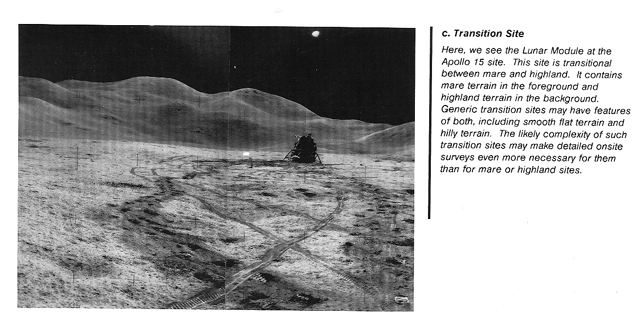
Lunar Site Characterization and Mining
Charles E. Glass
Before resources are committed to lunar mining, a significant amount of information will be needed. I hope that our workshop group will illuminate some of the more obscure areas, such as the specific requirements of an ore processing facility. Other important information can be acquired only through onsite exploration and testing.
Potential lunar mining sites can be divided into two general groups- generic sites and Apollo sites. Geologic data for both types of site are sparse and of poor spatial resolution
Generic sites have not been visited. They are potential mine sites only because they are in lunar regions with mineralogic properties that are generally understood by comparison of remotely sensed data with data from analysis of Apollo site samples; e.g., mare sites, highland sites, or transition sites. See figure 15. Generic sites will require exploration at a variety of scales.
Initial exploration using a satellite in lunar orbit will allow regional exploration of many generic sites. Polar sites, if suitable ones can be identified, have several advantages for a mining operation. First, the continuous solar radiation at the poles would enable continuous mining o perations under stable temperature and lighting conditions. (See figure 16.) Such an environment would eliminate the stress on mining equipment and personnel caused by the alternation of 2-week lunar nights and days at other sites. Second, the high thermal gradients encountered at the poles due to low Sun angles could help provide cryogenic storage for processing gases and product gases. Third, the potential occurrence of water frozen in the perpetually shadowed areas of the poles is an incentive for exploring polar sites.
Exploration of generic sites at intermediate scales is required to bridge the gap between the low- resolution remote sensing data and the more intensive measurements made by human beings. This intermediate-scale exploration could be done by automated rovers, which should be able to cover relatively large areas rather rapidly.
The automated nature of lunar exploration will demand advances in high-resolution sensing and in computer processing and integration of data acquired by different instruments on the same roving vehicle. Knowledge gained from terrestrial mineral exploration can be used for preliminary training of automated interpretation systems, but the unique conditions of the lunar environment will likely require an intelligent computer- vision system capable of "learning" and adjusting as new data become available.


Completion of these exploration programs should bring our knowledge of generic sites up to that of the Apollo sites, the second general category. Regional exploration is not deemed necessary for the Apollo sites because of the relatively extensive body of knowledge already assembled. However, detailed site investigations to obtain specific parameters for mine design will be required for the first mining attempt.
In outlining these exploration requirements, our workshop group made several assumptions. First, we assumed that the prototype lunar mining venture should be an unqualified success. Second, we assumed that the startup product would be liquid oxygen, with the subsequent addition of such byproducts as metals for structural use, ceramics, and bulk materials for shielding. Third, we assumed that the mining operation wou[a excavate lunar regolith and deliver a well-graded feedstock to the processing facility. (No crushing is required, with oversized material being removed mechanically.)
Specific Parameters for Mine Design
The final stage of the exploration program-to acquire specific parameters for mine design-will begin only after a chosen site has been as thoroughly explored as an Apollo site. Even for the Apollo sites, information is insufficient to assure the success of our first lunar mine. Factors that affect mining include mineralogy, grain size distribution, abrasiveness, depth of loosely compacted regolith, and surface topography. How these factors vary from place to place is not well understood. The Apollo missions were never intended to be resource appraisals. Nevertheless, a restudy of Apollo samples and survey data with an eye toward resource appraisal would be a promising first step toward obtaining the needed site detail.
Published information on Apollo 17 samples suggests a high degree of variability from place to place in mineralogy and in grain size distribution in soils. That variability is seen in samples numbering only in the tens taken over a 25-km2 area.
Next|
Curator: Al Globus If you find any errors on this page contact Al Globus. |
 |
This site was hosted by the NASA Ames Research Center from 1994-2018 and is now hosted by:
